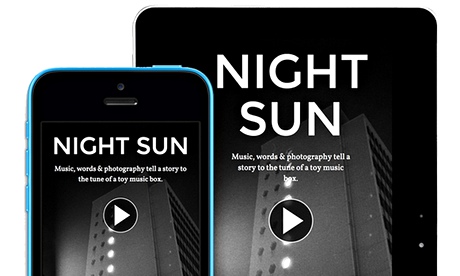
I bought my first music box because a friend wanted to make a film about one and for me to write the score. It was called Twinklebox – a short animation about a broken toy stuck in its own world, unable to stop making music. I wrote lots of little lullabies using the music box, trying to find one that suited the character.
After Twinklebox, I carried on punching holes in card strips to see what other sounds the music box could make. Night Sun, an innocent but sinister interactive audiovisual installation, emerged from one of these experiments.
I was originally commissioned by Nottingham City Council to produce Night Sun for Light Night, an event in February where the city at night becomes a playground and gallery. Recorded music on its own wouldn’t work; there’s so much noise in a city that you switch off, paying little or no attention to the sounds around you. So I came upon the idea that a user would have to activate the music and interact with it in some way to become involved with the piece.
I knew Arduino (an open-source electronics platform) would be the way to go and worked with Adrian McEwan, master of Arduino/Pi hacking, on capacitive sensing, which means the Arduino senses changes in the capacitance of metal wire when someone touches it, and then sends a signal to a computer.
The piece itself is a small, metal toy music box, so we attached the wire to that and instructed the Arduino to send a “play” command to a computer when it sensed someone touching it. When you turn the handle of the music box, its recorded sound plays on the computer.
Once the string quartet was recorded, it really felt like you were playing the instrument along with the recording. I also commissioned photographer Dan Wheeler to capture hidden parts of Nottingham at night, and writer Emma Lannie to author something mysterious inspired by the music and Dan’s photos.
Rather than combine the music, story and photos in video form, I used Jplayer and HTML to create a book-shaped projection. As the music plays in Jplayer, there are triggers at different points in time. These triggers correspond to page elements that are made visible when their time comes, fading in or appearing suddenly depending on the urgency of the words. The photos are set as backgrounds that change with each stanza.
I prefer developing in this way because I can easily change how the installation looks depending on the aspect ratio of the projection surface. It also means that Night Sun works on the web and as an app.
Releasing music in app (or web app) form is something a lot of people are talking about at the moment, from Bjork’s Biophilia to Radiohead’s Polyfauna and all of Brian Eno’s apps. For Night Sun Online, it felt like an extension of the physical installation, using new tools to put music in places you wouldn’t normally find it, presenting it in a different way than people are used to. A logical replacement or evolution of the music video perhaps. I don’t have the budgets that Bjork and Radiohead do, so simplicity is the key.
What were the challenges? The main problem with Night Sun Online has been describing what it is – or more importantly, how you’re supposed to use and approach it. When it’s the physical installation, the interaction is clear: you turn the handle and something happens. With the online version, you press “play” and then what? Yes, you listen. Yes, you read. But there’s a thing I would like people to notice, which is their inner voice (subvocalisation) bringing the words to life. That’s the thing I need to figure out how to tell people.
In terms of what’s next, Night Sun the installation continues to go down a storm, while its online counterpart is getting more and more attention as time goes on. I’ll release it via app stores this winter.
The aim of Night Sun was to see if people would engage with a piece of recorded string quartet music and words in a new kind of way, which it has achieved. With Night Sun Online, I wanted to test the water and see if this non-movie-movie – this musical animated book – would be appealing. It seems so, but I need to work out how to describe it better for my next work, Songs For Spoken Words.
Using a grant from Arts Council England/National Lottery, I’m focusing on six pieces of instrumental music that were initially written as guitar improvisations to accompany a poet when he performed. He doesn’t perform anymore, so I’ve expanded the music so that it’s a soundtrack to the poems, inspired by his performances.
A developer is iterating on the technology used in Night Sun to make it easier to code each piece. I’m animating the words to simulate the performance of the pieces, hoping the combination of soundtrack, typography and rhythmical phrase-by-phrase delivery of the words will enable people to be the performer. Whether out loud or internally.
App facts
• Length of the project: Installation, one month; online app, two weeks
• Companies involved: Time Travel Opps
• Size of the team: Richard Birkin (composer, producer, developer); Emma J Lannie (writer); Dan Wheeler (photographer)
More App stories
• How we made Radiohead’s PolyFauna app
• How we made the Live/Revive/Lament opera performance app
• How we made a circus app for children with autism
Richard Birkin is a composer – follow him on Twitter @rjbirkin
Join our community of arts, culture and creative professionals by signing up free to the Guardian Culture Pros Network.

